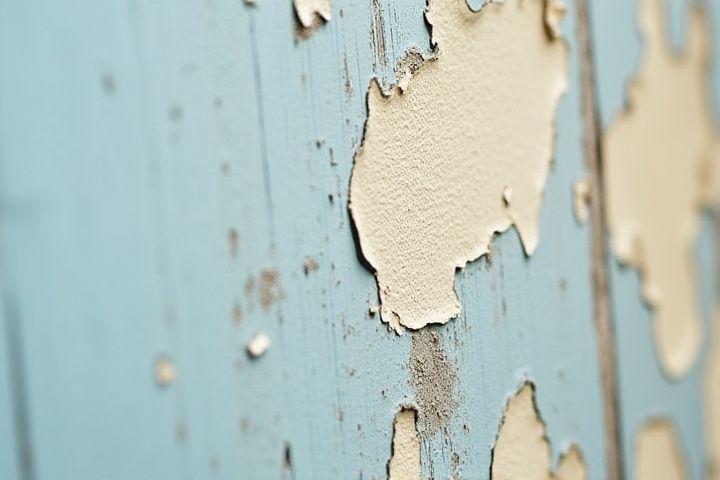
House paint can chip off due to several factors, including poor surface preparation, moisture intrusion, and temperature fluctuations. When the underlying surface, such as wood or drywall, is not adequately cleaned or primed, the paint fails to adhere properly. Moisture can seep beneath the paint layer, leading to blistering and eventual peeling, particularly in areas with high humidity or inadequate ventilation. Extreme temperature changes can also cause the paint to expand and contract, resulting in cracks that promote chipping. Regular maintenance, including proper cleaning and timely repainting, can help prevent these issues and prolong the lifespan of your home's exterior paint.
Why House Paint Chips Off
Poor surface preparation
Poor surface preparation is a primary reason why house paint chips off, leading to unsightly walls and costly repairs. If the surface is not cleaned thoroughly to remove dust, dirt, grease, or old peeling paint, it can prevent the new paint from adhering properly. Inadequate sanding or priming can also compromise the paint's bond, making it vulnerable to moisture and temperature fluctuations. Ensuring that surfaces are prepped correctly, including filling cracks and smoothing rough areas, is essential for the longevity of your paint job.
High moisture levels
High moisture levels can cause house paint to chip off due to the expansion and contraction of the underlying materials. When humidity infiltrates walls, it leads to the formation of blisters that weaken the paint's adherence. This can be exacerbated in areas prone to water exposure, where consistent dampness creates an environment ripe for deterioration. To minimize chipping, maintaining proper ventilation and managing indoor humidity levels below 50% is crucial.
Incorrect paint type
Incorrect paint type is a primary reason why house paint chips off. Using exterior paint on interior surfaces or vice versa can lead to adhesion failures, causing the paint to peel or flake over time. Furthermore, selecting a finish that doesn't match the surface, such as glossy paint on porous materials, can create weak bonds. To ensure durability, always choose paint formulated specifically for the intended environment and material.
Inadequate priming
Inadequate priming before painting can lead to a significant reduction in the adhesion of paint to surfaces, causing it to chip off over time. Primer serves as a bonding agent, sealing the surface and providing a stable foundation for the paint. Without proper priming, moisture and temperature fluctuations can penetrate the paint layer, exacerbating adhesion issues. To ensure durability and longevity of your paint job, always apply a suitable primer that matches the surface material and the type of paint you intend to use.
Temperature fluctuations
Temperature fluctuations can lead to significant issues with house paint adhesion, causing it to chip and peel. When temperatures rise and fall, the materials in your home's structure expand and contract, which creates stress on the paint layer. This movement can break the bond between the paint and the surface, particularly if the paint was not properly applied or if inferior quality paint was used. To enhance the durability of your paint job, consider choosing high-quality, temperature-resistant paints designed to withstand such environmental changes.
Application on damp surface
House paint can chip off when applied to damp surfaces due to poor adhesion. Moisture trapped beneath the paint creates a barrier that prevents proper bonding with the substrate. As evaporation occurs, the presence of water vapor can lead to blistering and peeling, compromising the durability of the paint. For optimal results, ensure surfaces are completely dry before application to enhance the longevity and appearance of your paint job.
Excessive humidity
Excessive humidity can lead to house paint chipping off due to the increased moisture in the air, which weakens the bond between the paint and the substrate. When humidity levels are high, water vapor can become trapped under the paint surface, causing peeling and flaking as the paint expands and contracts with temperature changes. This compromises the paint's integrity, often resulting in mold and mildew growth, further deteriorating the painted surface. To prevent paint chipping, it's essential to control indoor humidity levels and select paint specifically designed for high-moisture environments.
Improper application technique
Improper application technique is a leading cause of house paint chipping, with nearly 50% of paint failures attributed to this issue. Insufficient surface preparation, such as neglecting to clean or sand the area, can lead to poor adhesion, causing the paint to peel away easily over time. Application in unfavorable weather conditions, like high humidity or extreme temperatures, can also hinder the paint's ability to bond effectively, resulting in premature deterioration. When you opt for a roller or brush that is not suitable for the paint type, it can further compromise the finish, making it more susceptible to chipping.
Cheap or low-quality paint
Cheap or low-quality paint often lacks the necessary bonding agents and pigments, leading to premature wear and chipping. Inexpensive formulations typically contain a higher percentage of fillers, which reduces coverage and adhesion properties, making the paint more susceptible to environmental factors. When exposed to moisture, UV rays, or temperature fluctuations, this type of paint can break down faster, resulting in noticeable peeling or flaking. To ensure durability and longevity, investing in higher-quality paint with a proven track record can save you time and money on frequent touch-ups or repaints.
Overly thick paint layer
Overly thick paint layers can lead to poor adhesion and increased stress on the paint film, resulting in chipping. As the layers cure, they may trap moisture or air bubbles, causing the paint to lift away from the surface. When temperature fluctuations occur, the excessive thickness expands and contracts at different rates than the underlying material, intensifying the risk of delamination. You can prevent this issue by applying thin, even coats and ensuring proper surface preparation before painting.
